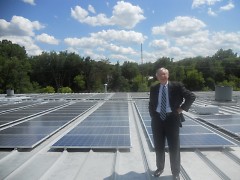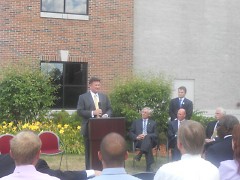On Tuesday, the city of Grand Rapids unveiled a solar panel array above the Water Systems Administration building at 1900 Oak Industrial Drive. This moves the city one step closer to its goal of securing 100 percent of its energy from renewable resources by 2020.
Mayor George Heartwell was in attendance, and referred to the array as “the first of many installations” you’ll see on city buildings in Grand Rapids.
The new system is expected to generate approximately 135,000 Kilowatt hours (kWh) of clean solar energy each year, which will be used to power 25 percent of the building.
Since May, the new system has already produced over 36,000 kWh and is expected to pay for itself within eight years. However, due to the high amount of energy being generated, it may pay itself off earlier.
“Four years ago, solar panels were twice as expensive and half as powerful,” said Tom Brown, Senior Account Executive for Innovateus Solar, the company that manufactures the panels.
The new system, which is expected to last up to 40 years, will provide electricity for the building as well as minimize energy costs by keeping the building cool. Brown also said he expects future models to be even more efficient.
The city spent $500,000 to acquire the solar panels, with a grant from the US Department of Energy paying for half the total cost. The purchase is part of an agreement with Consumers Energy that requires the city to sell excess energy back to Consumers Energy.
Currently, the panels occupy roughly a quarter of the roof. Depending on how well the system operates, future buildings will also receive the renewable energy panels.
The Rapidian, a program of the 501(c)3 nonprofit Community Media Center, relies on the community’s support to help cover the cost of training reporters and publishing content.
We need your help.
If each of our readers and content creators who values this community platform help support its creation and maintenance, The Rapidian can continue to educate and facilitate a conversation around issues for years to come.
Please support The Rapidian and make a contribution today.


